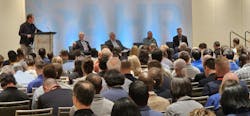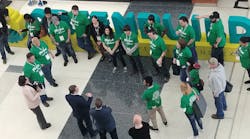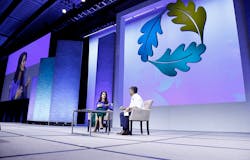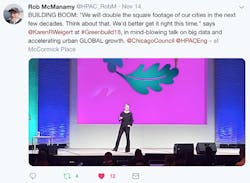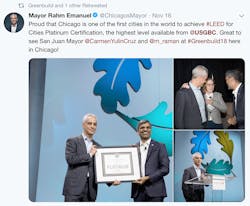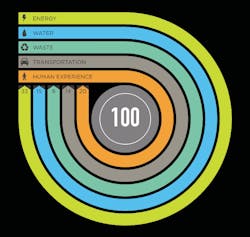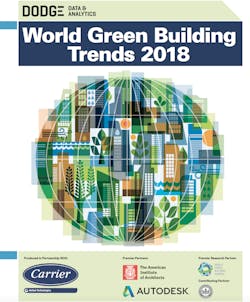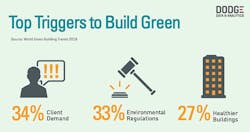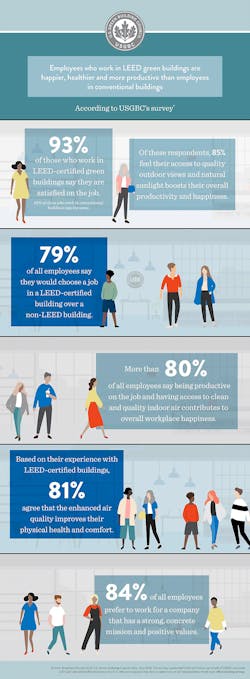Even as more statistical evidence was released to bolster its validity in the marketplace, an estimated 15,000 members of the U.S. green building community descended on Chicago’s massive McCormick Place Convention Center last month to share best practices, to encourage each other in the face of political resistance, and also to inspire hundreds of students on hand to prepare to carry the torch forward.
“This community of green builders has been preparing for the challenges ahead – and throughout our history, we have always managed to transform obstacles into opportunities,” said Mahesh Ramanujam, president and CEO of event host U.S. Green Building Council (USGBC), which celebrated its 25th anniversary this year. “Today, there are more than 7 billion square feet of LEED-certified space on our planet, and our community of LEED professionals is more than 200,000 strong. And we have witnessed the green building market transform into a trillion-dollar global industry.”
To underscore that financial aspect of the sustainability market, USGBC released a new report from Dodge Data & Analytics, World Green Building Trends, which surveyed more than 2,000 engineers, architects, contractors, subcontractors and consultants in 86 countries. Nearly half of the respondents (47%) said that they expect to do the majority (60%) of their projects green by 2021.
“We’ve seen the shift toward more efficient, sustainable buildings,” says Chris Nelson, President of Commercial HVAC at Carrier Corp., a premier sponsor of the study. “The trends uncovered in this report reflect what we’re seeing in our business – building green is good for the public health, the environment, and the bottom line.”
Dodge Data produced the study in partnership with Carrier, USGBC, the American Institute of Architects (AIA), Autodesk, and the World Green Building Council.
“As the industry continues to embrace technology, our customers are taking advantage of automated workflows that put real-time data at the center of each project and allow teams to collaborate during all stages.” said Lynelle Cameron, VP, Sustainability, Autodesk & CEO Autodesk Foundation. “Energy analysis tools and generative design also allow designers to use data to create better options.”
Using technology to measure building performance has become an increasing priority for USGBC, ever since it launched its LEED intelligence-gathering software Arc Skoru Inc. in late 2016. Since then, the Green Business Certification Institute product has been offered to all LEED-certified buildings, as well as to those not yet certified but looking to improve sustainability and occupant health conditions. Well-received so far, Arc calculates a building’s performance score “based on a global data set and action-oriented strategies across five categories: energy; water; waste; transportation; and human experience.”
Other Greenbuild highlights included these LEED rating updates:
• LEED Zero Certification – USGBC officially introduced a new LEED Zero certification offering. The new program recognizes buildings or spaces operating with net zero carbon emissions from energy consumption and occupant transportation to carbon emissions avoided or offset over a period of 12 months. LEED projects can achieve LEED Zero certification when they demonstrate any or one of the following: net zero carbon emissions, net zero energy use, net zero water use or net zero waste;
• Integration of STAR and LEED for Cities and LEED for Communities – It was announced that the STAR Community Rating System, which offers certification for sustainable communities, has been fully integrated into USGBC’s LEED for Cities and LEED for Communities programs, to help advance sustainable cities and communities worldwide. There are currently 75 cities and communities that have achieved STAR certification and 20 additional cities and communities that are seeking STAR certification. All of these localities will transfer into the family of LEED for Cities and LEED for Communities;
• LEED Recertification – USGBC announced that it will begin offering LEED recertification. All LEED projects – past, present and future – are now eligible for recertification by providing 12 months of data, powered by Arc, that shows consistent or improved performance, using the most recent version of the LEED rating system. This recertification will be valid for three years and is an important step in ensuring that a green building is operating the way it was intended.
Greenbuild 2019 will take place Nov. 20-22 in Atlanta, at the Georgia World Congress Center. USGBC’s call for proposals are now open.
